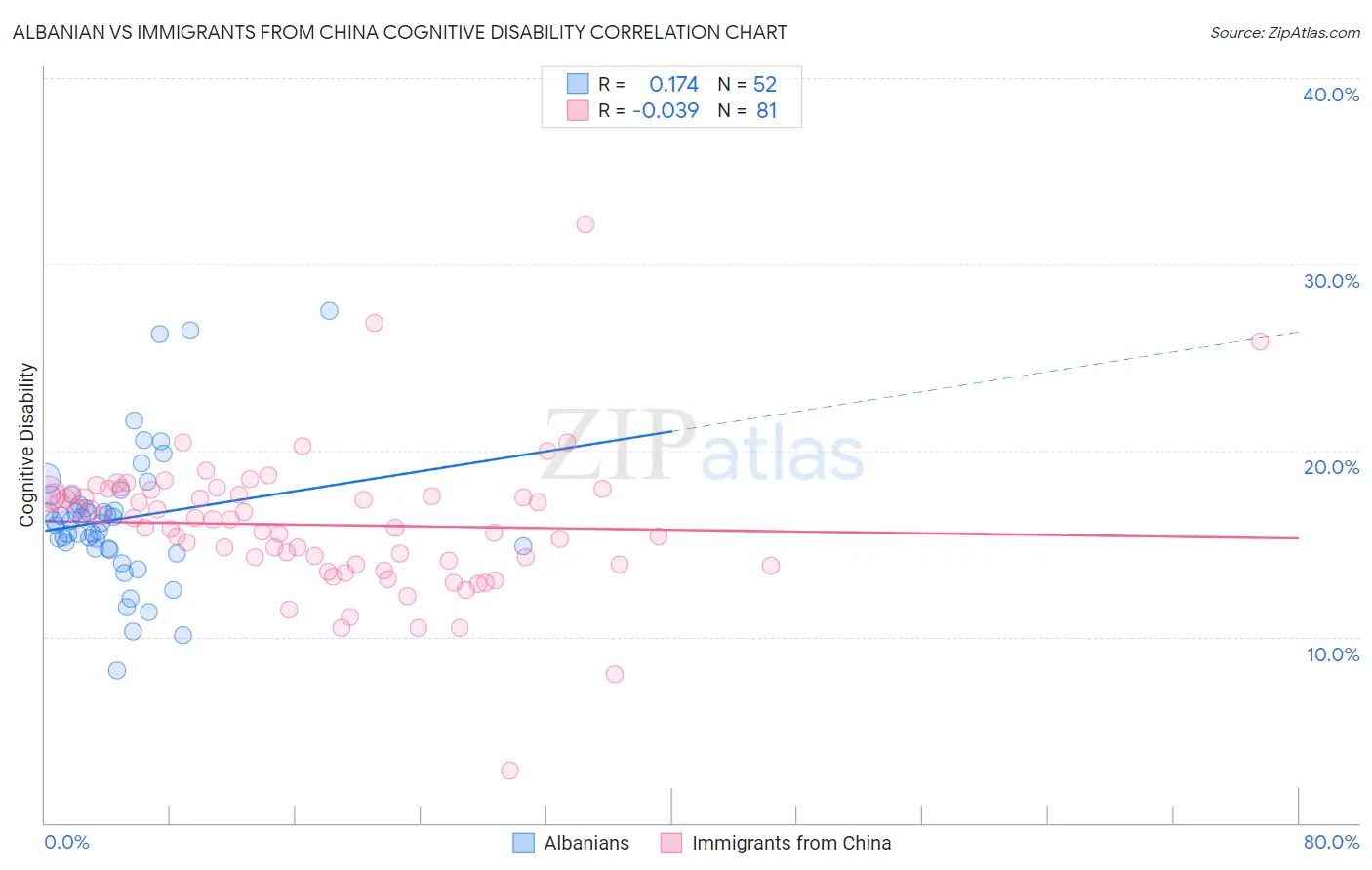Albanian vs Immigrants from China Cognitive Disability
COMPARE
Albanian
Immigrants from China
Cognitive Disability
Cognitive Disability Comparison
Albanians
Immigrants from China
16.8%
COGNITIVE DISABILITY
97.3/ 100
METRIC RATING
109th/ 347
METRIC RANK
16.9%
COGNITIVE DISABILITY
94.9/ 100
METRIC RATING
121st/ 347
METRIC RANK
Albanian vs Immigrants from China Cognitive Disability Correlation Chart
The statistical analysis conducted on geographies consisting of 193,265,298 people shows a poor positive correlation between the proportion of Albanians and percentage of population with cognitive disability in the United States with a correlation coefficient (R) of 0.174 and weighted average of 16.8%. Similarly, the statistical analysis conducted on geographies consisting of 457,042,790 people shows no correlation between the proportion of Immigrants from China and percentage of population with cognitive disability in the United States with a correlation coefficient (R) of -0.039 and weighted average of 16.9%, a difference of 0.49%.

Cognitive Disability Correlation Summary
| Measurement | Albanian | Immigrants from China |
| Minimum | 8.2% | 2.8% |
| Maximum | 27.5% | 32.2% |
| Range | 19.3% | 29.4% |
| Mean | 16.3% | 16.0% |
| Median | 16.2% | 16.3% |
| Interquartile 25% (IQ1) | 14.7% | 13.9% |
| Interquartile 75% (IQ3) | 17.3% | 17.7% |
| Interquartile Range (IQR) | 2.6% | 3.8% |
| Standard Deviation (Sample) | 3.7% | 3.8% |
| Standard Deviation (Population) | 3.6% | 3.8% |
Demographics Similar to Albanians and Immigrants from China by Cognitive Disability
In terms of cognitive disability, the demographic groups most similar to Albanians are Arapaho (16.8%, a difference of 0.010%), Uruguayan (16.8%, a difference of 0.020%), Indian (Asian) (16.8%, a difference of 0.040%), Canadian (16.8%, a difference of 0.050%), and Immigrants from Sri Lanka (16.8%, a difference of 0.050%). Similarly, the demographic groups most similar to Immigrants from China are Scottish (16.9%, a difference of 0.020%), Immigrants from Western Europe (16.9%, a difference of 0.020%), Portuguese (16.9%, a difference of 0.030%), Turkish (16.9%, a difference of 0.050%), and South African (16.9%, a difference of 0.10%).
| Demographics | Rating | Rank | Cognitive Disability |
| Immigrants | Eastern Asia | 97.9 /100 | #105 | Exceptional 16.8% |
| Northern Europeans | 97.8 /100 | #106 | Exceptional 16.8% |
| Immigrants | Nicaragua | 97.8 /100 | #107 | Exceptional 16.8% |
| Canadians | 97.5 /100 | #108 | Exceptional 16.8% |
| Albanians | 97.3 /100 | #109 | Exceptional 16.8% |
| Arapaho | 97.3 /100 | #110 | Exceptional 16.8% |
| Uruguayans | 97.2 /100 | #111 | Exceptional 16.8% |
| Indians (Asian) | 97.2 /100 | #112 | Exceptional 16.8% |
| Immigrants | Sri Lanka | 97.1 /100 | #113 | Exceptional 16.8% |
| Koreans | 97.1 /100 | #114 | Exceptional 16.8% |
| Yup'ik | 96.9 /100 | #115 | Exceptional 16.9% |
| Inupiat | 96.5 /100 | #116 | Exceptional 16.9% |
| Immigrants | Japan | 96.2 /100 | #117 | Exceptional 16.9% |
| Immigrants | Denmark | 96.2 /100 | #118 | Exceptional 16.9% |
| South Africans | 95.5 /100 | #119 | Exceptional 16.9% |
| Scottish | 95.0 /100 | #120 | Exceptional 16.9% |
| Immigrants | China | 94.9 /100 | #121 | Exceptional 16.9% |
| Immigrants | Western Europe | 94.8 /100 | #122 | Exceptional 16.9% |
| Portuguese | 94.7 /100 | #123 | Exceptional 16.9% |
| Turks | 94.5 /100 | #124 | Exceptional 16.9% |
| Scandinavians | 94.1 /100 | #125 | Exceptional 16.9% |